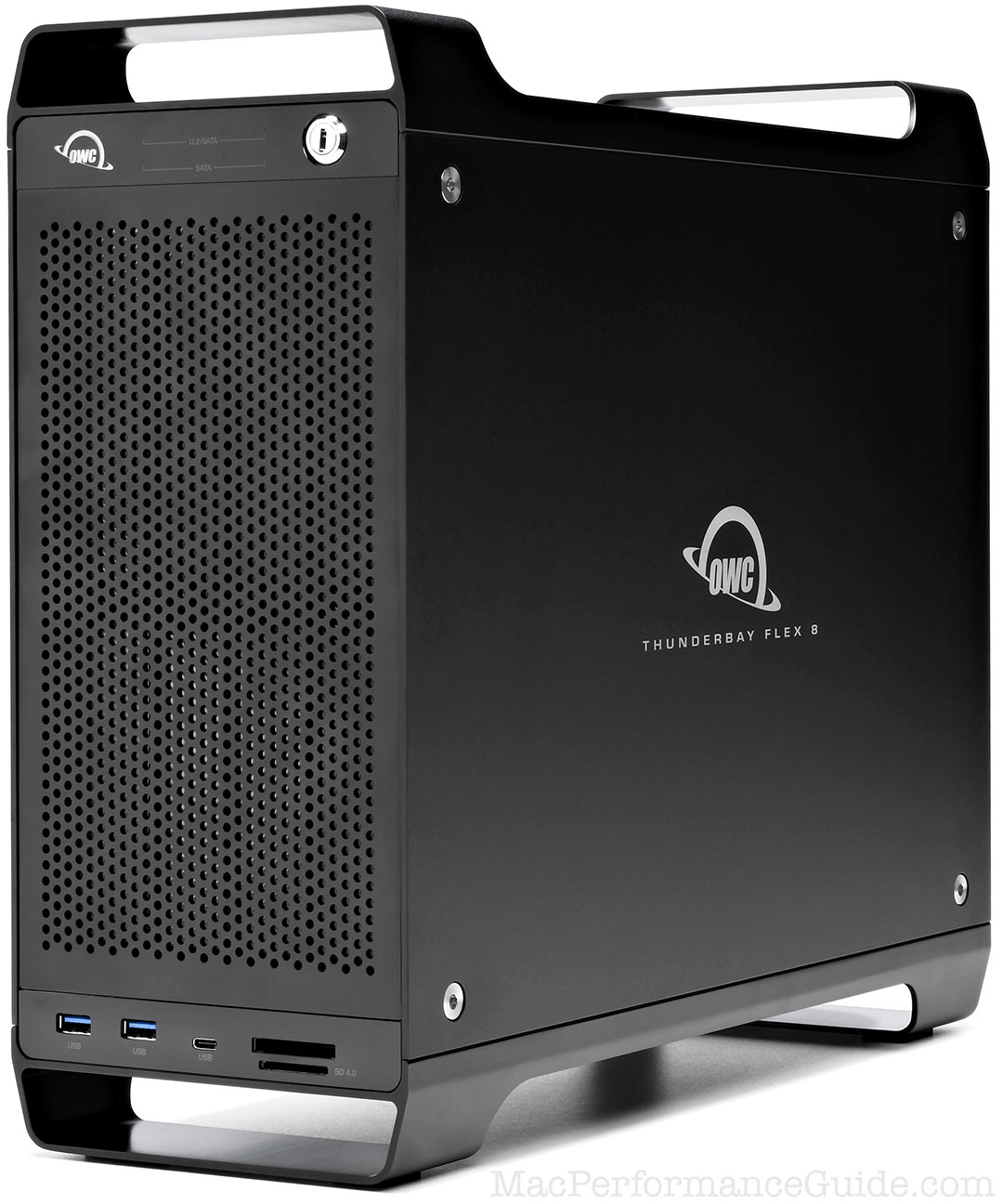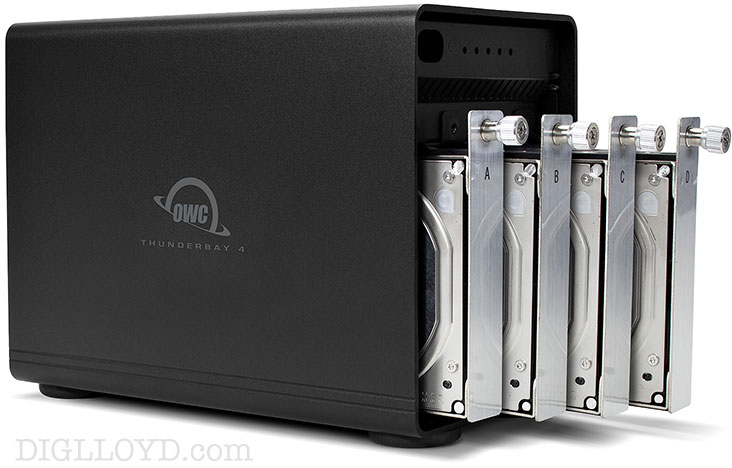
|

|

|

|

|

|
Depth of Field—D2X vs EOS 1Ds Mark II and Canon 5D
Related: Canon 5D, depth of field, diffraction, digital sensor, field of view, post processing
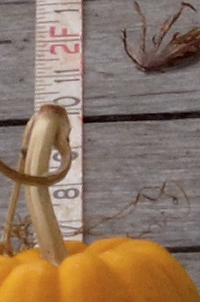 |
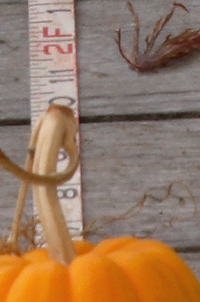 |
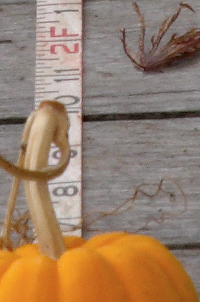 |
This is an excerpt from the 2005 D2X vs EOS review, now located in DAP.
The discussion here is relative to the review of the 16.7-megapixel Canon EOS 1Ds Mark III, 12.8-megapixel Canon EOS 5D, and the 12.2-megapixel Nikon D2x.
Depth of field is a significant consideration for many applications due to the very high resolution of these cameras. A 12 or 16-megapixel camera records all its pixels, whether they are blurry or sharp. When care is not taken, a 6-megapixel camera can provide the same amount of actual detail as a 12-megapixel camera—see Focus Accuracy as well as my Feb 17 blog entry.
When considering sharpness, it is important to ask “how many sharp pixels overall?” Overall sharpness is often the goal, though the opposite might be desirable for some subjects (eg a blurred background for portraits).
Image detail is a function of not just the maximal resolving power of the lens and sensor combined, but also the sharpness of the subject as it recedes from the plane of precise focus. For three-dimensional (non-planar) subjects, “sharpness” takes on a more complex meaning. For that matter, one hopes that the imaging sensor is aligned at 90° to the optical axis—not always true.
While the Canon EOS 1Ds Mark II has the highest pixel dimensions of these cameras (1DsM2, 5D, D2x), and thus can be expected to show the highest level of detail at the plane of precise focus, its full-frame sensor requires a 1.51X-longer lens focal length as compared with the 2/3-frame sensor of the Nikon D2X (to achieve the same field of view from the same position). The depth of field of this longer focal length lens will be less, and thus sharpness averaged over the entire frame might be lower.
The Canon 5D suffers (or enjoys) the same depth of field limitations as the 1DsMII, and yet has barely more resolution than the D2X, so in subjects that require significant depth of field the 5D can be expected to fare less well as compared with the D2X
The test scene
The scene shown below was carefully prepared in order to assess how depth of field behaves on these cameras. [The pumpkins are primarily for fun]. White balance was done using the Macbeth Color Checker card. Here is the scene as shot:
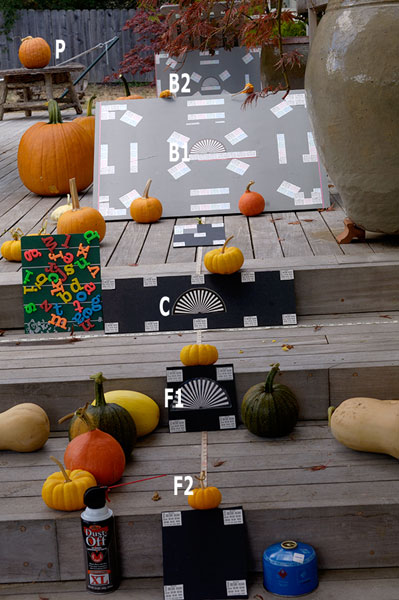
For a valid comparison, the plane of focus and field of view must match between cameras. In the test scene, high-contrast test targets were placed at key distances. These include:
- Point C, the point of focus.
- Points F1, F2, the foreground targets.
- Points B1, B2, the background targets.
- Point P, the Pumpkin in the upper left.
Equivalent field of view was verified using the horizontal rule just below point C.
On the Nikon D2X, the 28-70/f2.8 AFS zoom was used, zoomed to 45mm (marked). On the Canon 1DsMII and 5D, the 24-105/f4L IS zoom was used (image stabilization disabled). The lens was zoomed to match the field of view rendered on the D2X; this was checked on the computer during the shoot. The maximum difference (between the D2X and 5D) was 0.75% :
| Camera | Relative Magnification 43 inches on horizontal rule |
|---|---|
| Nikon D2X | 3267 pixels = 1.00 |
| Canon EOS 1Ds Mark II | 3275 pixels = 1.00245 |
| Canon EOS 5D | 3292 for 43" = 1.00765 |
When examining the images, especially point C, bear in mind that the 5D has this very slight resolution and magnification advantage over the D2X, and the 1DsMII has about a 16% resolution advantage.
The 5D and D2X images were upsized to match the resolution (width in pixels) of the 1DsMII image (3328).
If you'd like to see one humongous page with all the cameras at all apertures and all points, click here.
The point of focus—Point C
Point C is up first for examination. Point C is important in order to determine that accurate focus was achieved at the same point for all the cameras. There should be blur in both directions away from the target. That goal has been achieved. There might be a tiny difference in focus point, but it is difficult to say exactly where that might be.
The 1DsMII shows its superior resolution. Examine in particular the “30” bars in the lower and upper targets shown below. The resolution difference makes it more difficult to distinguish the depth-of-field differences on this target, though there are hints of differences.
The image quality of each camera as the lens is stopped down might also be of interest. See the complete f-stop series for Point C: D2X, 5D, 1DsMII.
| Nikon D2X 45mm | Canon EOS 5D 70mm | Canon EOS 1DsMII 70mm |
|---|---|---|
 |
 |
 |
The optimal aperture for both lenses is about f8. Some improvement is seen, particularly in the foreground (examine the “3” on the tape measure). The slightly superior resolution of the 1DsMII is evident.
| Nikon D2X 45mm | Canon EOS 5D 70mm | Canon EOS 1DsMII 70mm |
|---|---|---|
 |
 |
 |
8-bay Thunderbolt 3
2.5 or 3.5 inch hard drives, NVMe SSD, USB-C, USB-A, DisplayPort 1.4, SD slot, PCIe slot, 500W power supply.
Non-RAID or RAID-0/1/4/5/10.
Capacities up to 128 Terabytes!
Point B1
Point B1 is the closest background target to Point C, the point of focus.
At f4 the difference is not so obvious, but the D2X shot is showing slightly better sharpness; try to read the word “BLACK” on all 3 shots below.
The image quality of each camera as the lens is stopped down may also be of interest. See the complete f-stop series for Point C: D2X, 5D, 1DsMII.
| Nikon D2X 45mm | Canon EOS 5D 70mm | Canon EOS 1DsMII 70mm |
|---|---|---|
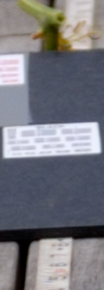 |
 |
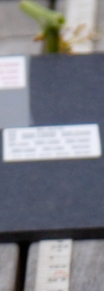 |
At f5.6, the D2X is clearly the sharpest of the three cameras:
| Nikon D2X 45mm | Canon EOS 5D 70mm | Canon EOS 1DsMII 70mm |
|---|---|---|
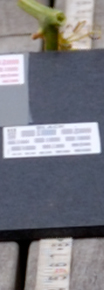 |
 |
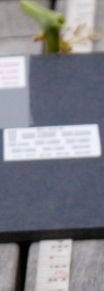 |
At f8, the D2X is about as sharp as the 1DsMII in the foreground, even though the 1DsMII has 17% higher resolution. In the background (the number on the tape measure), the D2X is significantly sharper than either the 5D or 1DsMII.
| Nikon D2X 45mm | Canon EOS 5D 70mm | Canon EOS 1DsMII 70mm | |
|---|---|---|---|
| no sharpening | 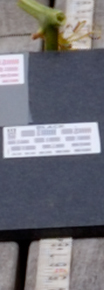 |
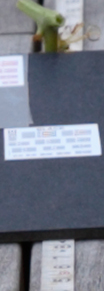 |
 |
| Unsharp Mask 500,0.3,4 |
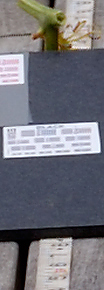 |
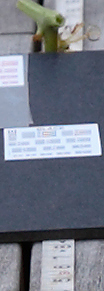 |
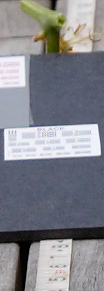 |
At f11, the three cameras are nearly equal, though the higher resolution of the 1DsMII gives it the lead in resolving power. The D2X has also begun to suffer from diffraction, the contrast being lower now than at f8 above. The D2X and 5D are about equal.
| Nikon D2X 45mm | Canon EOS 5D 70mm | Canon EOS 1DsMII 70mm | |
|---|---|---|---|
| no sharpening | 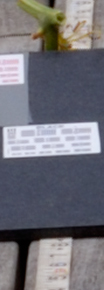 |
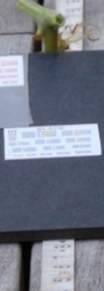 |
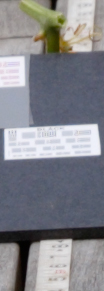 |
| Unsharp Mask 500,0.3,4 |
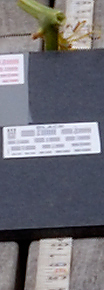 |
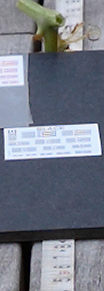 |
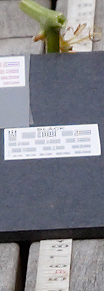 |
At f16, the D2X image contrast is declining noticeably (due to diffraction). The 5D and 1DsMII are less affected at f16, as their larger pixels do not suffer as much from the effects of f16 diffraction. The 1DsMII ekes out a small sharpness advantage due to its higher resolution.
| Nikon D2X 45mm | Canon EOS 5D 70mm | Canon EOS 1DsMII 70mm | |
|---|---|---|---|
| no sharpening |  |
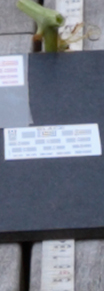 |
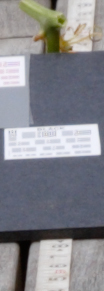 |
| Unsharp Mask 500,0.3,4 |
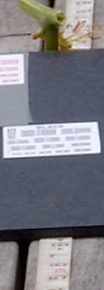 |
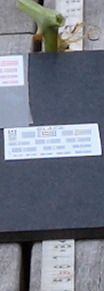 |
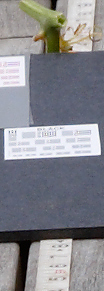 |
At f22, all the cameras are suffering from diffraction, with the DX quality seriously impacted because the diffraction spot-size (roughly 7 microns) is now larger than the 5.5-micron pixel size of the D2X (8.2 microns for the 5D and 7.2 microns for the 1DsMII). Unsharp masking is unable to salvage the D2X image. as fine detail is just no longer present. The 5D image is on par with the 1DsMII image, possibly a bit better.
| Nikon D2X 45mm | Canon EOS 5D 70mm | Canon EOS 1DsMII 70mm | |
|---|---|---|---|
| no sharpening | 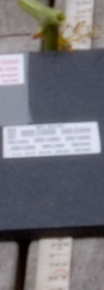 |
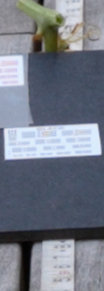 |
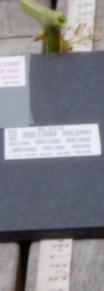 |
| Unsharp Mask 500,0.3,4 |
 |
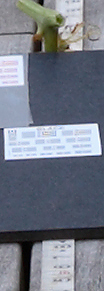 |
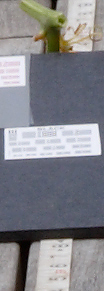 |
Point B2
Point B2 is the rearmost background point using the resolution charts. The target just in front of it is shifted for the 5D images due to the target not being secured in the slight breeze, and having to be repositioned (and clamped down the 2nd time!). However, it remained at the same distance, and the rearmost target did not shift at all. There is also a slight perspective shift between the D2X and 1DsMII due to the difference in the physical size (height) of the cameras.
At f4, all shots are blurry , but the D2X shot shows the least amount of blur, with less of a halo around the details.
| Nikon D2X 45mm | Canon EOS 5D 70mm | Canon EOS 1DsMII 70mm |
|---|---|---|
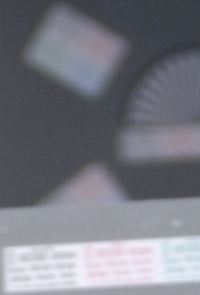 |
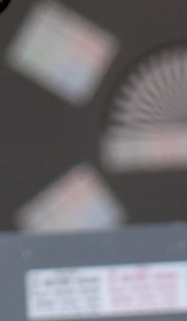 |
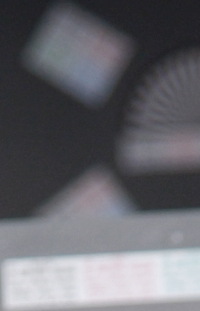 |
At f5.6, the D2X is the sharpest of the three cameras by a good margin, though this is an academic issue given the amount of blur for all the cameras. Note that the 5D and 1DsMII images look larger due to the blurring effect:
| Nikon D2X 45mm | Canon EOS 5D 70mm | Canon EOS 1DsMII 70mm |
|---|---|---|
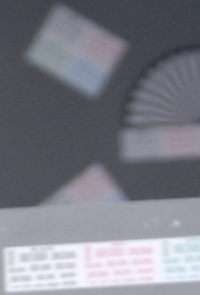 |
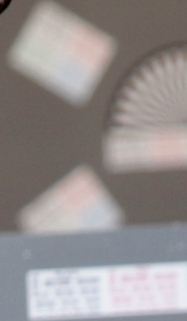 |
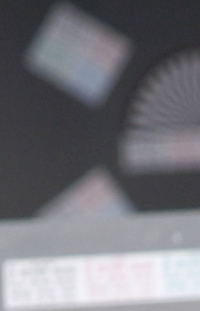 |
At f8, the D2X holds a pronounced lead over the 5D and 1DsMII, with the word “BLACK” almost readable:
| Nikon D2X 45mm | Canon EOS 5D 70mm | Canon EOS 1DsMII 70mm |
|---|---|---|
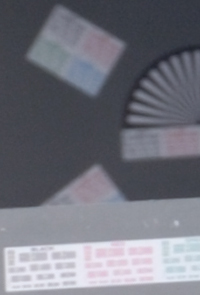 |
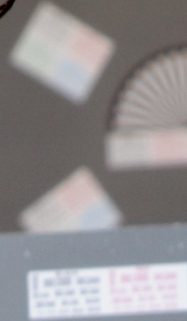 |
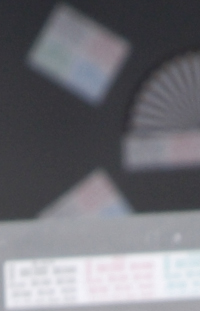 |
At f11, the D2X continues to hold the lead, though on the foreground target the 5D and 1DsMII are getting closer:
| Nikon D2X 45mm | Canon EOS 5D 70mm | Canon EOS 1DsMII 70mm |
|---|---|---|
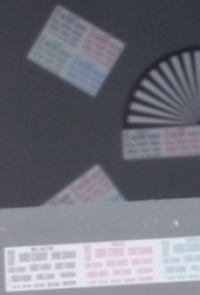 |
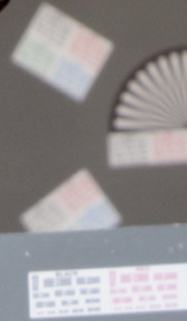 |
 |
At f16, the D2X image quality is holding up well as compared with f11; stopping down has increased the background sharpness at minimal cost to the foreground. The 5D and 1DsMII images are about equal with the D2X in the foreground, but are still much blurrier in the background:
| Nikon D2X 45mm | Canon EOS 5D 70mm | Canon EOS 1DsMII 70mm |
|---|---|---|
 |
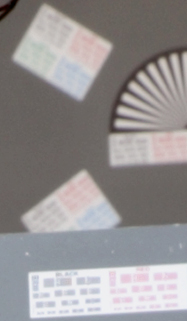 |
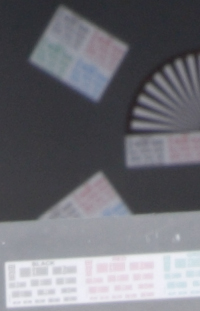 |
At f22, even suffering from strong diffraction effects, the D2X holds its own against the 5D and 1DsMII. The sharpness-robbing effects of diffraction are still more than compensated for by the depth of field advantage (in this specific case).
| Nikon D2X 45mm | Canon EOS 5D 70mm | Canon EOS 1DsMII 70mm |
|---|---|---|
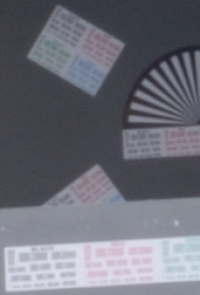 |
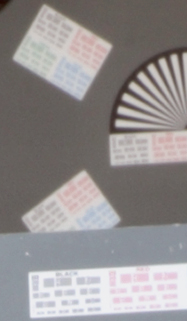 |
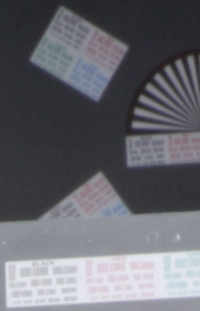 |
Point P
Point P is the furthest area we'll examine, containing the pumpkin, with the hammock rope and chain roughly 30 feet behind it, and the fence another 50 feet behind that.
Note that this series of images has been scaled to fit the width of the page. The browser you are using should show the 900-pixel-wide jpegs as 600 pixels wide on this page. To see the unscaled “actual pixels” versions, click here. [Note: some browsers might not scroll to the correct position; scroll down if this occurs.]
At f4, all shots are blurry , but the D2X shot shows the least amount of blur.
| DOF test, Point P @ f4 |
|---|
| Nikon D2X @ 45mm |
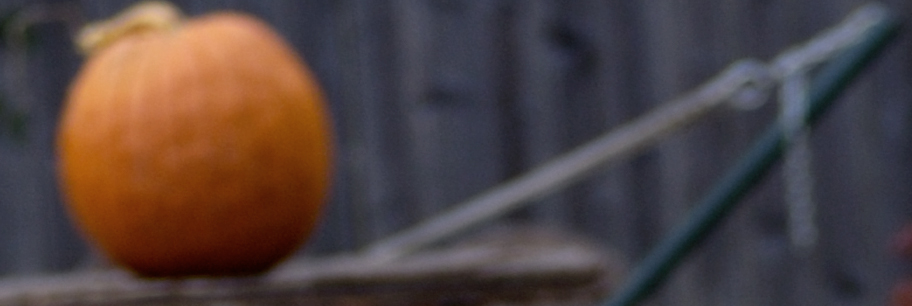 |
| Canon EOS 5D @ 70mm |
 |
| Canon EOS 1DsMII @ 70mm |
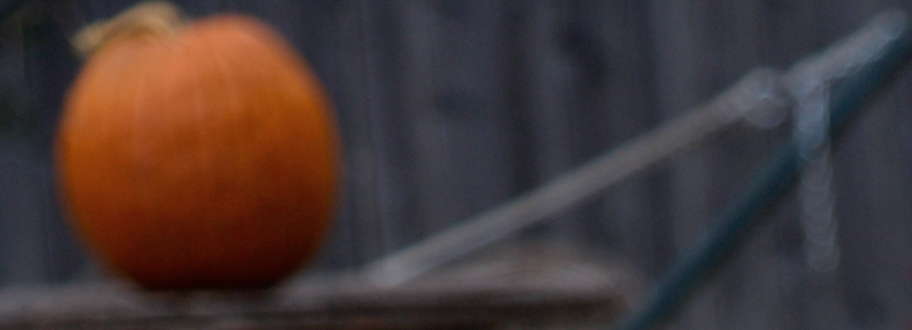 |
At f5.6, the D2X is starting to resolve finer areas; the 5D and 1DsMII are still quite blurry:
| DOF test, Point P @ f5.6 |
|---|
| Nikon D2X @ 45mm |
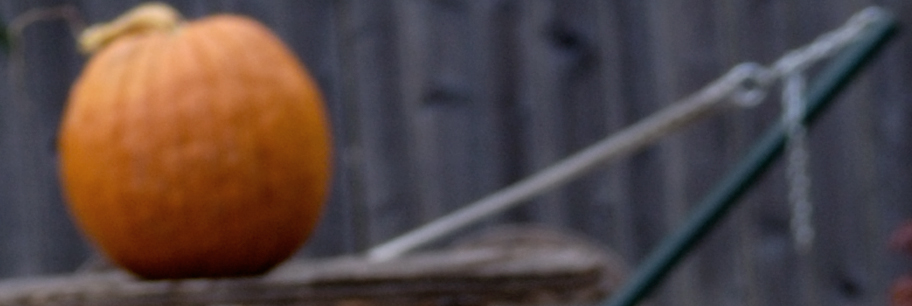 |
| Canon EOS 5D @ 70mm |
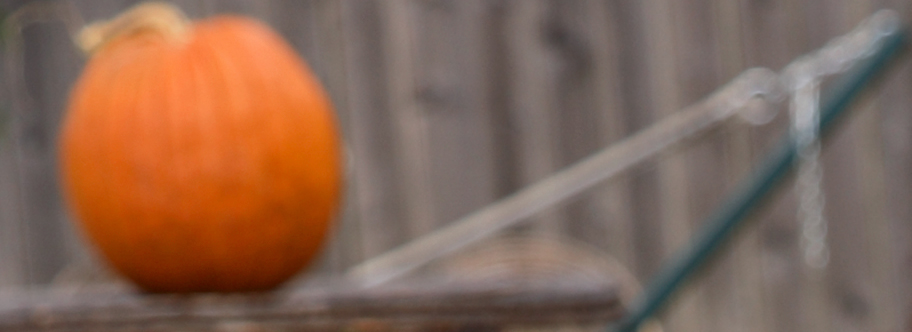 |
| Canon EOS 1DsMII @ 70mm |
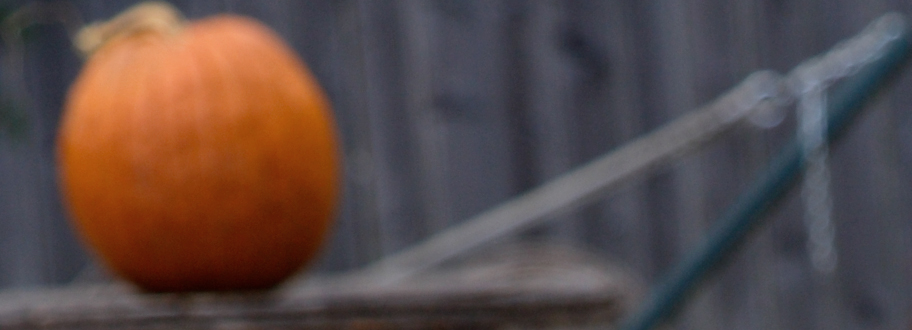 |
At f8, the D2X holds a significant lead over the 5D and 1DsMII:
| DOF test, Point P @ f8 |
|---|
| Nikon D2X @ 45mm |
 |
| Canon EOS 5D @ 70mm |
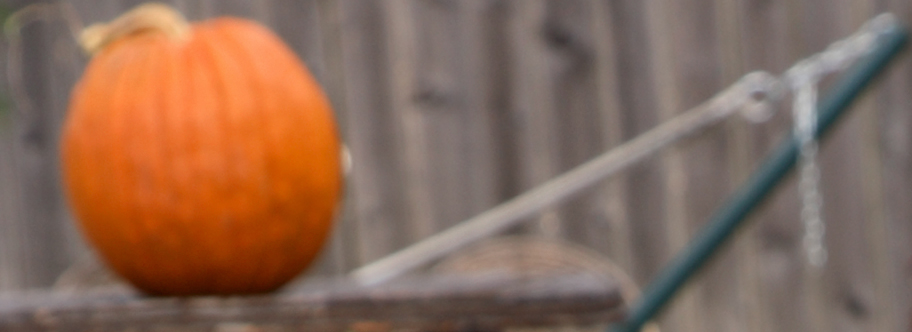 |
| Canon EOS 1DsMII @ 70mm |
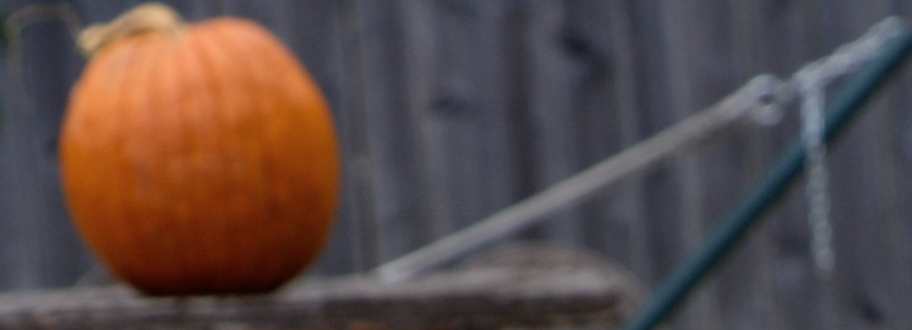 |
At f11, the D2X is still much sharper:
| DOF test, Point P @ f11 |
|---|
| Nikon D2X @ 45mm |
 |
| Canon EOS 5D @ 70mm |
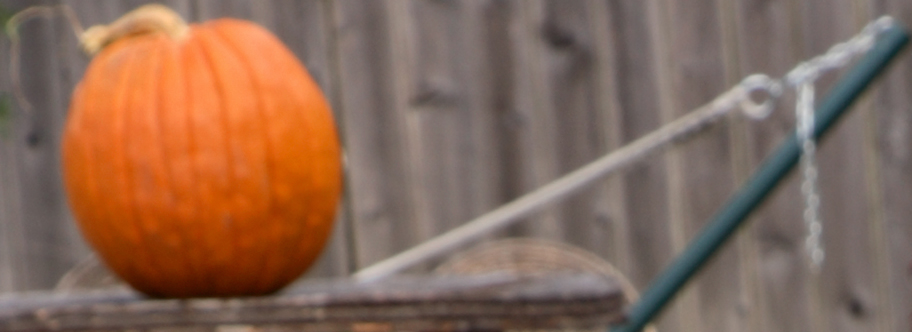 |
| Canon EOS 1DsMII @ 70mm |
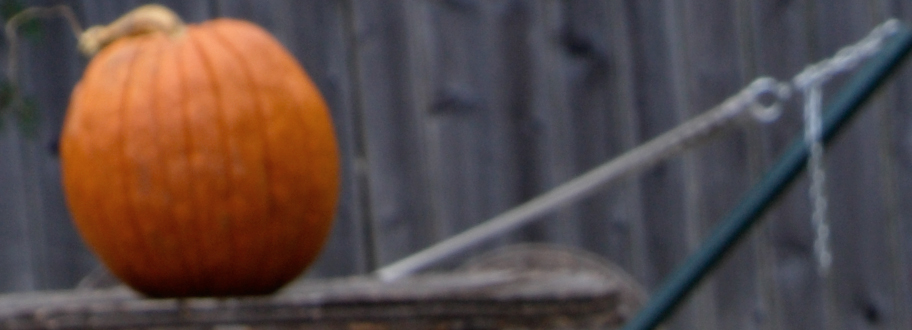 |
At f16, the D2X image quality is holding up well as compared with f11; stopping down has increased the sharpness significantly. The 5D and 1DsMII images are noticeably softer, with the 1DsMII offering no advantage over the 5D:
| DOF test, Point P @ f16 |
|---|
| Nikon D2X @ 45mm |
 |
| Canon EOS 5D @ 70mm |
 |
| Canon EOS 1DsMII @ 70mm |
 |
At f22, even suffering from strong diffraction effects, the D2X image is still somewhat better than the 5D and 1DsMII. There is little difference between the 5D and 1DsMII.
| DOF test, Point P @ f22 |
|---|
| Nikon D2X @ 45mm |
 |
| Canon EOS 5D @ 70mm |
 |
| Canon EOS 1DsMII @ 70mm |
 |
High capacity, high-performance fault-tolerant storage for photography and video.
Non-RAID or RAID-0/1/4/5/10.
Capacities up to 72 Terabytes!
Point F1
Point F1 is the foreground point closest to the point of focus.
At f4, the D2X shot is the least blurred, though all shots are blurry.
The image quality of each camera as the lens is stopped down may also be of interest. See the complete f-stop series for Point F1: D2X, 5D, 1DsMII.
| Nikon D2X 45mm | Canon EOS 5D 70mm | Canon EOS 1DsMII 70mm |
|---|---|---|
 |
 |
 |
At f5.6, the cameras appear similar. Oddly the 5D and 1DsMII appear to be slightly sharper. Perhaps there was slight camera movement in this frame for the D2X (or some optical oddity):
| Nikon D2X 45mm | Canon EOS 5D 70mm | Canon EOS 1DsMII 70mm |
|---|---|---|
 |
 |
 |
At f8, the D2X is sharper than the 1DsMII and the 5D. Both the lines and the letters are better delineated on the D2X image.
| Nikon D2X 45mm | Canon EOS 5D 70mm | Canon EOS 1DsMII 70mm | |
|---|---|---|---|
| no sharpening |  |
 |
 |
| Unsharp Mask 500,0.3,4 |
 |
 |
 |
At f11, all cameras have improved. The D2x is still the equal of either EOS camera, though the 1DsMII is hinting at higher resolution.
| Nikon D2X 45mm | Canon EOS 5D 70mm | Canon EOS 1DsMII 70mm | |
|---|---|---|---|
| no sharpening |  |
 |
 |
| Unsharp Mask 500,0.3,4 |
 |
 |
 |
At f16, the D2X image contrast is declining (due to diffraction).
The 5D now approaches the D2X resolution.
Strictly speaking, the 1DsMII ekes out a small sharpness advantage, but the D2X image still looks very favorable by comparison.
| Nikon D2X 45mm | Canon EOS 5D 70mm | Canon EOS 1DsMII 70mm | |
|---|---|---|---|
| no sharpening |  |
 |
 |
| Unsharp Mask 500,0.3,4 |
 |
 |
 |
At f22, all the cameras are suffering from diffraction, with the DX quality seriously impacted because the diffraction spot-size (roughly 7 microns) is now larger than the 5.5-micron pixel size of the D2X (8.2 microns for the 5D and 7.2 microns for the 1DsMII). The 1DsMII image is a hair better than the 5D image.
| Nikon D2X 45mm | Canon EOS 5D 70mm | Canon EOS 1DsMII 70mm | |
|---|---|---|---|
| no sharpening |  |
 |
 |
| Unsharp Mask 500,0.3,4 |
 |
 |
 |
Point F2
Point F2 is the foreground closest to the camera.
At f4, the D2X shot is the least blurred, though all shots are blurry.
The image quality of each camera as the lens is stopped down may also be of interest. See the complete f-stop series for Point F1: D2X, 5D, 1DsMII.
| Nikon D2X 45mm | Canon EOS 5D 70mm | Canon EOS 1DsMII 70mm |
|---|---|---|
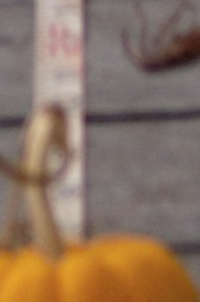 |
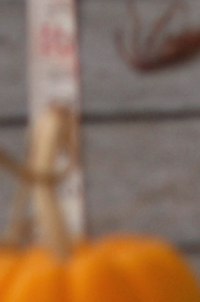 |
 |
At f5.6, the cameras appear to be about the same, but there is a bit less blur on the D2X image:
| Nikon D2X 45mm | Canon EOS 5D 70mm | Canon EOS 1DsMII 70mm |
|---|---|---|
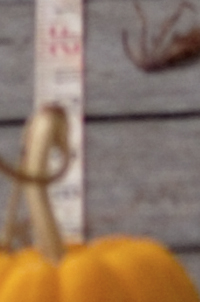 |
 |
 |
At f8, the D2X is sharper than the 1DsMII and the 5D. Both the lines and the letters are better delineated on the D2X image.
| Nikon D2X 45mm | Canon EOS 5D 70mm | Canon EOS 1DsMII 70mm |
|---|---|---|
 |
 |
 |
 |
 |
 |
At f11, all cameras have improved. However, the D2X presents the crispest detail.
| Nikon D2X 45mm | Canon EOS 5D 70mm | Canon EOS 1DsMII 70mm |
|---|---|---|
 |
 |
 |
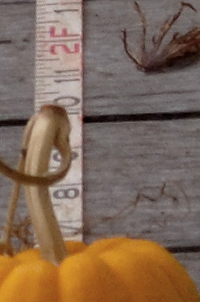 |
 |
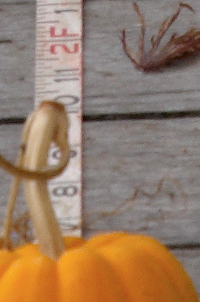 |
At f16, the D2X image contrast is declining (due to diffraction). Still, the D2X compares favorably with the 1DsMII. The 5D still shows some softness in the tendrils on the pumpkin:
| Nikon D2X 45mm | Canon EOS 5D 70mm | Canon EOS 1DsMII 70mm |
|---|---|---|
 |
 |
 |
 |
 |
 |
As usual, the D2X image quality is now reduced at f22. The 1DsMII image is a hair sharper than the 5D image:
| Nikon D2X 45mm | Canon EOS 5D 70mm | Canon EOS 1DsMII 70mm |
|---|---|---|
 |
 |
 |
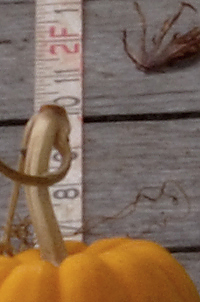 |
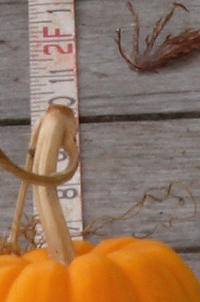 |
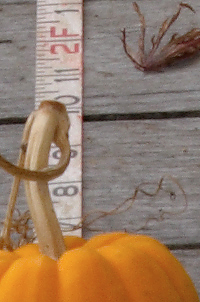 |
Conclusions
[Please see a previous diglloyd article: “Depth of Field: The Shorter Focal Length Advantage” for an example with a longer focal length.]
A smaller sensor offers increased depth of field, due to the use of a shorter focal-length lens to achieve the same field of view from the same position. The reverse (more blur) is also true, and this is why some photographers like larger format cameras, which require longer focal lengths. These statements are made based on human vision; technical arguments against it are unpersuasive use your eyes.
At a minimum, the D2x has a depth of field advantage of about one stop. The advantage appears to be slightly more than this, perhaps 1.5 stops, but certainly less than 2 stops. As the focal length becomes shorter, this advantage is less of an issue, because adequate depth of field is obtained relatively easily. As the focal length becomes longer, equivalent depth of field may not be obtainable with a full-frame camera because there is a minimum aperture (typically f22) which may still not be small enough. In this case, the D2X at f22 will be able to produce more depth of field than a full-frame camera also limited to f22.
The increased depth of field available with the 12.1-megapixel D2X has a neutralizing effect on the resolution advantage of the 16.7-megapixel Canon EOS 1Ds Mark II. The 1DsMII exhibits its superior resolution in a limited zone determined by the plane of focus, and the aperture. It does appear that for many photographs this zone will be adequate for the 1DsMII to produce the more detailed image overall.
The Canon 5D, with only a minimal resolution advantage over the D2x, can only hope to match the D2x, whether at the plane of focus, or farther from it. However, it does generally offer higher image contrast, which can produce the perception of more detail.
When maximal depth of field is desirable, and stopping down the lens is not an attractive option (eg a higher shutter speed), the D2X might be a better choice, producing more sharp pixels overall than the 1DsMII or 5D at the same aperture. However, when a higher shutter speed is required, raising the ISO by 1.5 stops on the EOS bodies might be a satisfactory solution to allowing a smaller aperture, especially in light of the excellent noise characteristics of the EOS bodies.
When minimal depth of field is desirable in order to separate the subject from the fore/background, the longer focal length associated with the larger sensor offers a potential advantage. Medium format and large format shooters seek out this effect.


















